04-Verilog基础_3
Module
Module是verilog中的关键字,是对电路建模的最小单元。verilog中构建一个电路,对于一个硬件进行描述在module中进行。

半加器

module half_adder(S,C,A,B);
output S,C;
input A,B;
wire S,C,A,B;
assign S = A ^ B;
assign C = A & B;
endmodule
全加器

module full_adder(sum,cout,in1,in2,cin);
output sum,cout;
input in1,in2,in3;
wire sum,cout,in1,in2,cin;
half_adder ha1(I1,I2,in1,in2);
half_adder ha2(sum,I3,I1,cin);
assign cout = I2 || I3;
endmodule
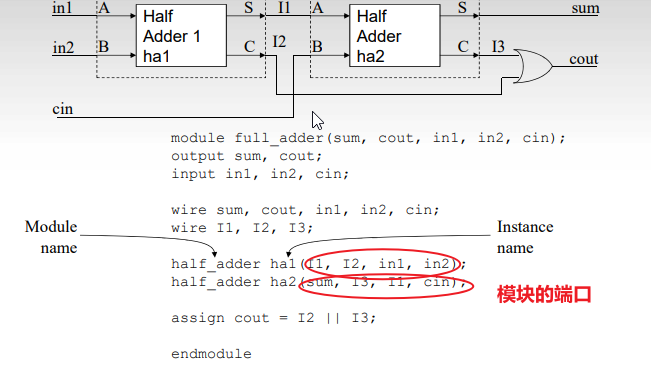
Hierachical Names

Continuous Assignments(连续赋值语句)
- 将左侧和右侧连起来,建立连接关系

- 线网类表示逻辑门与模块之间的连接,具体的类型有:wire、wand、wor、tri、triand、trior、tri0、tri1、trireg、uwire、supply0、supply1

Structural Model(Gate Level)



- 组合逻辑电路是没有DFF的,触发器如何描述,取决于综合逻辑工具。
半加器的实现
- 使用verilog中的门电路实现半加器
module half_adder(S,C,A,B);
output S,C;
input A,B;
wire S,C,A,B;
xor #2 (S,A,B);
and #1 (C,A,B);
endmodule
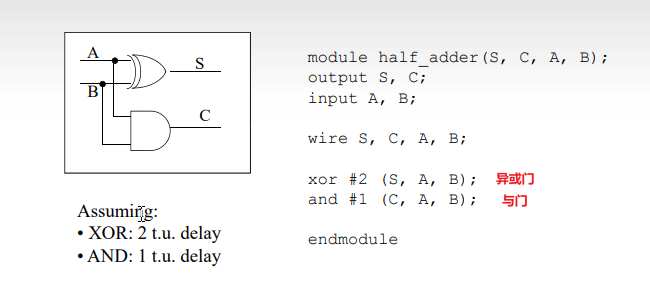
- 这种门电路的实现是不推荐的,这里的门电路相当于将RTL代码进行逻辑综合之后映射到特定工艺库中的东西。
Behavioral Model-Procedure(i)


- 实现二选一的mux
begin
if(sel == 0)
Y = B;
else
Y = A;
end


Block statement
- fork-join是不可综合的,不能用于构建电路
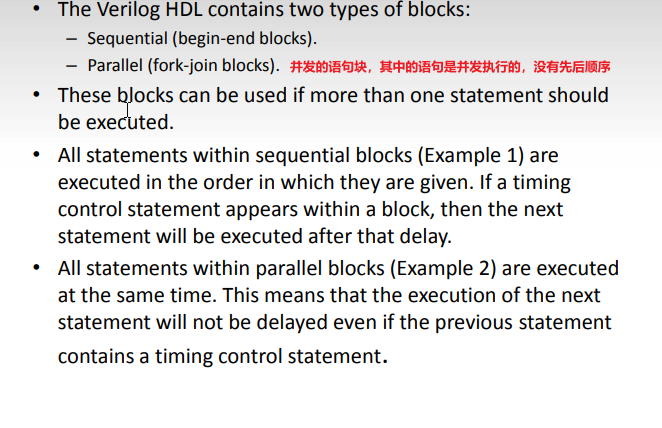
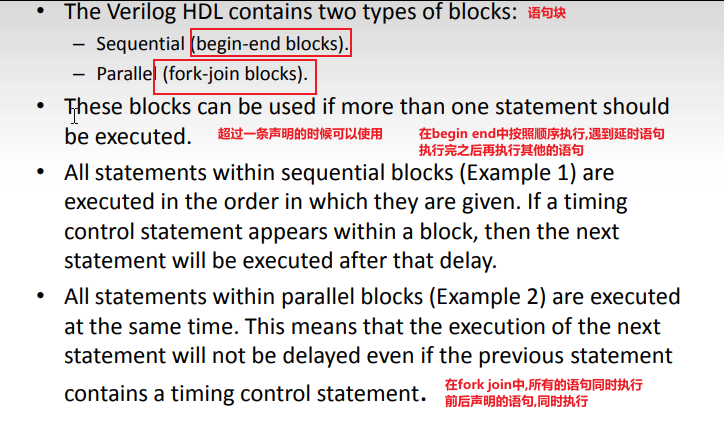


Initial & Always
- @--等的意思



event

半加器实现--always语句

- 半加器和DFF
// half adder
module half_adder(S,C,A,B);
output S,C;
input A,B;
reg S,C;
always @(A or B){
S = A ^ B;
C = A && B;
}
endmodule
//DFF
module dff(Q,D,Clk);
output Q;
input D,Clk;
reg Q;
wire D,Clk;
always @(posedge Clk){
Q = D; //这里这种写法是错误的,应该使用非阻塞赋值写法
}
endmodule
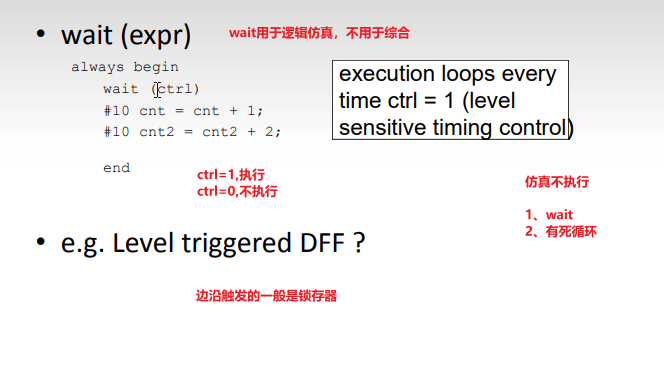

Timing
- verilog语言中特有的


if

四选一mux实现

// 4-to-1 mux
module mux 4_1(out,in,sel);
output out;
input [3:0] in;
input [1:0] sel;
reg out;
wire in,sel;
always @(in or sel)
if(sel == in[0])
out = in[0];
else if(sel == in[1]
out = in[1];
else if(sel == in[2]
out = in[2];
else
out = in[3];
endmodule
- 还可以使用三目运算符
case

实现四选一
module mux 4_1(out,in,sel);
output out;
input [3:0] in;
input [1:0] sel;
reg out;
wire [3:0] in;
wire [1:0] sel;
always @(in or sel)
case (sel)
2'b00 : out = in[0];
2'b01 : out = in[1];
2'b10 : out = in[2];
2'b11 : out = in[3];
endcase
endmodule
for

- 可以实现计数器
module count(Y,start);
output [3:0] Y;
input start;
reg [3:0] Y;
wire start;
integer i;
initial
Y = 0;
always @(posedge start)
for(i = 0;i < 3;i = i+1)
#10 Y = Y + 1
endmodule
- for循环是不是可综合的,取决于循环变量是不是固定的
while

repeat


forever

- 时钟建模
module test;
reg Clk;
initial begin
clk = 0;
foever #10 clk = ~clk;
end
other_module o1(clk,....);
other_module o2(...,clk,...);
endmodule


